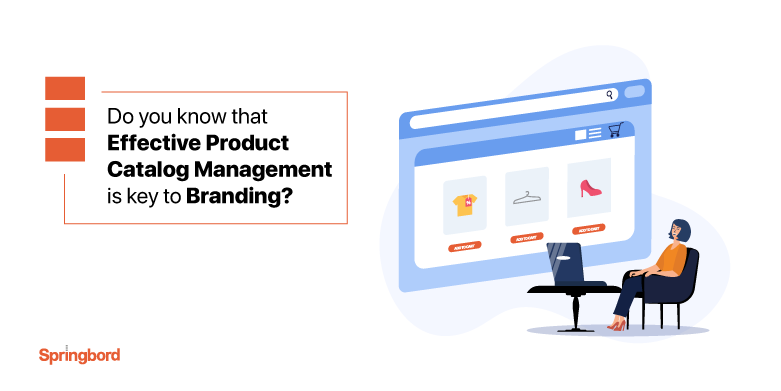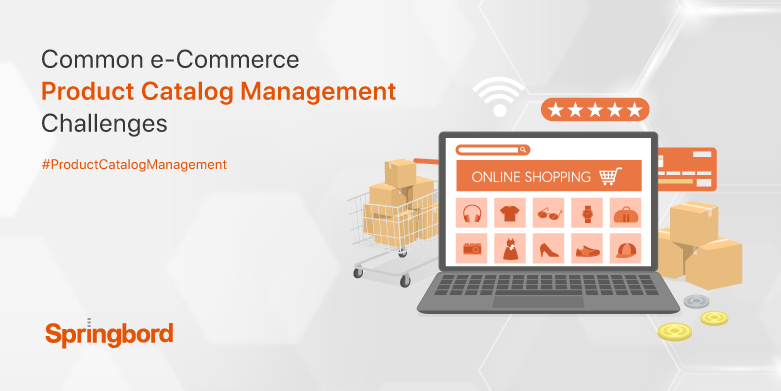 Read time 3 min
Read time 3 minManaging an e-commerce catalog can be a challenging task, especially as your business grows and your product offerings expand.
An organized and up-to-date catalog is essential to ensure a positive shopping experience for your customers and to drive sales. However, with so many products to manage and multiple sales channels to maintain, it’s easy to become overwhelmed.
In this article, we’ll explore the best practices for managing your e-commerce catalog and how Springbord’s expert catalog management services can help streamline the process.
- Create a Centralized Product Database:
One of the most important steps in managing your e-commerce catalog is to create a centralized product database. This database should contain all relevant product information, including product names, descriptions, images, SKUs, and pricing. By having all of your product information in one place, you can easily update and manage your catalog across all sales channels.
- Ensure Consistency Across Channels:
Consistency is key when it comes to managing your e-commerce catalog. Ensure that all product information is consistent across all sales channels, including your website, social media platforms, and third-party marketplaces. This includes ensuring that product names, descriptions, and images are consistent and that pricing and inventory levels are up-to-date.
- Optimize Product Listings:
Optimizing your product listings is essential to ensure that your products are easily searchable and stand out to potential customers. This includes using relevant keywords in your product descriptions, using high-quality images, and providing detailed product information. By optimizing your product listings, you can increase your visibility and drive sales.
- Monitor and Manage Inventory:
Inventory management is crucial in e-commerce, as it directly impacts your ability to fulfil customer orders. Regularly monitor your inventory levels and update them accordingly to avoid overselling or underselling products. Use automated inventory management tools to streamline the process and ensure accuracy.
- Utilize Catalogue Management Tools:
Catalogue management tools can significantly simplify the process of managing your e-commerce catalogue. These tools can automate tasks such as updating product information, managing inventory, and optimizing product listings. By utilizing catalogue management tools, you can save time and resources, and focus on growing your business.
- Categorize Your Products:
Categorizing your products can make it easier for customers to find what they’re looking for on your website or marketplace. Divide your products into relevant categories and subcategories, and make sure that they’re easy to navigate. This can improve the customer experience and increase the likelihood of a sale.
- Update Product Information Regularly:
It’s essential to keep your product information up-to-date to ensure accuracy and consistency across all sales channels. Regularly update product names, descriptions, and images to reflect any changes or improvements to the product. This can help you maintain customer trust and loyalty.
- Track Sales Performance:
Tracking sales performance is important to understand what products are selling well and which ones are not. This can help you make informed decisions about inventory management and product development. Use analytics tools to track sales performance and identify trends and patterns in customer behavior.
- Optimize for Mobile:
As more customers shop on mobile devices, it’s important to optimize your e-commerce catalog for mobile. Ensure that your website or marketplace is mobile-friendly and that product information is easily readable on a smaller screen. This can improve the customer experience and increase the likelihood of a sale.
- Monitor Competitors:
Keep an eye on your competitors and monitor their product offerings and pricing. This can help you stay competitive and make informed decisions about your own product development and pricing strategy. Use competitor analysis tools to identify opportunities for growth and improvement.
Conclusion:
Managing an e-commerce catalog requires organization, attention to detail, and a commitment to ensuring consistency across all sales channels. By following the best practices outlined in this article, you can simplify the process and ensure a positive shopping experience for your customers. S
pringbord’s expert catalog management services can help you streamline your catalog management process and optimize your e-commerce catalog for success.







